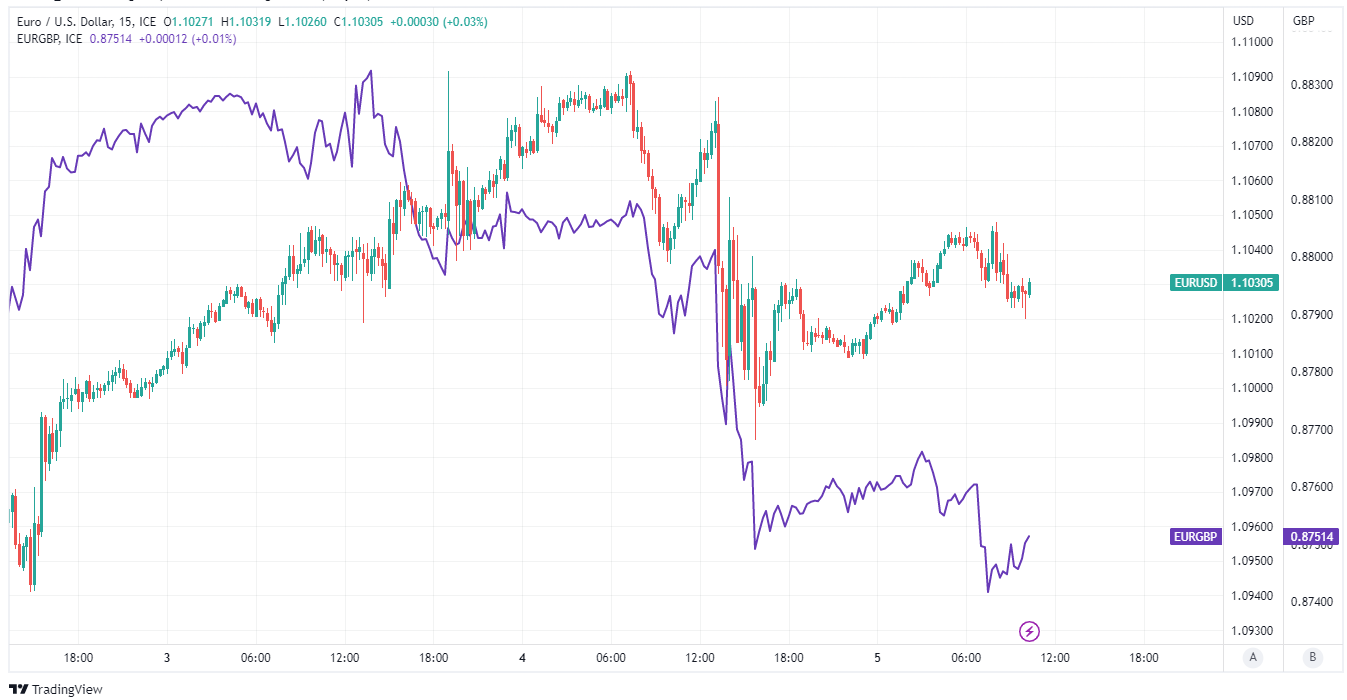Euro and European Central Bank Outlook: Analyst and Economist Views
- Written by: James Skinner
"It is obviously the fact that interest rate decisions that we made and the interest rates level we are on are having an effect. Is it a sufficient effect yet? We don’t know," European Central Bank President Christine Lagarde.

Image © European Central Bank
The Euro to Dollar exchange rate edged higher in the final session of the week as financial markets contemplated Euro Area economic data and what it might mean for a European Central Bank (ECB) interest rate policy that is now increasingly dividing analyst and economist opinions about the outlook.
German factory orders fell by 10.4% in March and much more heavily than the -2.4% expected by economists when data was released by Destatis on Friday while French industrial production also declined by more than envisaged, leaving the zero percent March increase of Italian retail sales appearing to be the sole bright spot in Friday's data.
While Italian retail sales did fall -0.3% in real or inflation-adjusted terms, economists had on average looked to see them fall -0.3% in outright or overall terms so the data would appear to cast the Mediterranean country as a bright spot in the wider Euro Area economy.
"It is obviously the fact that interest rate decisions that we made and the interest rates level we are on are having an effect. Is it a sufficient effect yet? We don’t know," President Christine Lagarde said in Thursday's press conference.
"We are not seeing the transmission at this point in time into what I call the second leg of the economy, which is the real activity, which then has an impact on prices and then reduces inflation. The full cycle we are not seeing yet," she added.
Above: Euro to Dollar rate shown at 15-minute intervals alongside EUR/GBP.
Friday's data matters because the real economy is increasingly a focus of the ECB, which is watching economic data closely for signs of its interest rate policy having the desired effect of reducing demand, spending and prices beyond the food and energy categories.
Europe's overall inflation rate edged higher from 6.9% to 7% when data for April was released on Tuesday but the core inflation rate fell from 5.7% to 5.6% once energy and food items are removed from the basket of goods in which prices are measured.
Meanwhile, the European Central Bank made a clear commitment on Thursday to raising interest rates further but one that was caveated with dependence on economic data emerging over the coming months and conditional on the wheels not falling off the financial sector or wider economy along the way.
This was after the first quarter Bank Lending Survey showed earlier this week that so far real economy demand for credit has been impervious to the effects of the bank's monetary tightening, and even as corporate demand for new borrowing has slowed markedly.
Hency why the ECB's judgment remained that borrowing costs are likely to rise further until "sufficiently restrictive" to ensure a timely return of inflation to the 2% target, leading to a more nuanced set of analyst and economist views on the outlook going forward.
Mark Wall, chief economist, Deutsche Bank
"The ECB has now hiked the deposit facility rate by 375bp over the coursecourse of 9 months, a very rapid tightening."
"We interpret the latest ECB decision as a ‘hawkish 25’. First, between the action to accelerate full exit from APP reinvestments and the non-action on TLTRO, the ECB’s decision had the maximum contractionary impact on its balance sheet. Second, the policy statement had several hawkish elements, including the description of inflation, the continuing above- target inflation forecast despite the tighter BLS, and the soft guidance to expect further hikes (plural)."
"We are holding our baseline view of a 3.75% terminal rate, with 25bp hikes in June and July. However, our earlier description of balanced risks around a 3.50-4.00% landing zone is no longer appropriate. It feels much less likely that the hiking cycle will end at 3.50% after one more hike in June."
"We see upside risks to our 3.75% call again — a 4%+ terminal rate is possible. Given sticky underlying inflation and robust labour market dynamics, the data going forward need to confirm that transmission is strengthening if the ECB hiking cycle is to stop at 3.75%."
David Oneglia, Europe economist, TS Lombard
"As Christine Lagarde emphasized in the Q&A, with rates now in restrictive territory (confirmed by bank lending data), “a general, very strong consensus” formed supporting a shift down to a 25bp hikes, also in light of potential “renewed financial market tensions”.
"Finally, despite Lagarde's denial, the Fed inching closer to a pause yesterday is also likely to have encouraged a move towards smaller hikes. That said, shifting down to 25bp hikes does not bring the ECB closer to a pause."
"The ECB is clear that the “inflation outlook continues to be too high for too long” and that there is “more ground to cover”. So, the question remains where the ECB will stop. For now, we stick to our call for a 3.75% terminal rate."
"However, it's possible to draw up scenarios in which the ECB terminal rate goes higher. The biggest risk comes from the uncertainty about the global growth outlook in 2023H2, and especially the odds of a mid-year US recession and its spillovers to the Euro Area. The ECB had nothing to say about the global outlook in its own growth risk assessment."
"While my colleague Steve Blitz's central case is still a mid-year US recession triggered by the tech-finance nexus, the rest of the US economy remains robust, leaving a chance that a recession is pushed back further. Again, this is not our baseline, but in the latter case, EA growth would be buoyed and higher wage growth in a still tight job market could better cushion the impact of monetary tightening on the real economy, pushing the ECB to hike a little longer beyond July."
Roukaya Ibrahim, strategist, BCA Research
"The post-meeting depreciation of EUR/USD – which was the worst performing G10 currency on Thursday – indicates that the ECB’s communication was a dovish surprise for currency market participants."
"Our colleagues from the European investment team have highlighted a repricing of rate expectations for the Fed relative to the ECB as one of the key near-term risks to their bullish outlook for EUR/USD and recommend investors hedge against a drop to EUR/USD 1.05."
"The biggest driver of structural inflation is wage inflation. This is because wages are the main cost in the services that comprise about two-thirds of any developed economy. To be more precise, the biggest component of structural inflation is wage inflation in excess of productivity growth, because if you get paid more for producing more, then it is not inflationary."
"On this basis, wage inflation in excess of productivity growth is still running much too hot in both the US and the euro area for their central banks’ 2 percent inflation targets. Cooling wage inflation will require more labor supply or less labor demand. As central banks have no remit over labor supply, they must reduce labor demand. Crucially though, firms cut back job openings and jobs only under the duress of a profits squeeze. Therefore, pulling inflation lower entails pulling corporate profits sharply lower."
Sven Jari Stehn, chief Europe economist, Goldman Sachs
"Taken together, today’s communication was close to our expectations and we maintain our forecast for 25bp hikes in June and July for a terminal rate of 3.75%."
"While a further sharp tightening in financing conditions (for example, on the back of renewed banking concerns in Europe) could lead to an earlier end to the tightening cycle, we still see the risks around 3.75% as skewed to the upside given the ongoing resilience in growth, strong wage growth and our sticky core inflation forecast, which remains notably above the ECB staff’s."
Mark McCormick, global head of FX strategy, TD Securities
"Ultimately, we think the EUR reaction boils down mostly to disappointed positioning. Markets had to reprice some lingering expectations of a 50bp hike. Also keep in mind our positioning model, PIT, highlights that markets are long EUR, though again it is not extreme."
"Much like the Fed and others we’re stuck in data dependent mode, which will continue to limit a universal FX theme and keep the chop fest going. Still, relative Fed/ECB policy speeches have been a bit more hawkish for the ECB, especially as the latter has "more ground to cover.""
"The market is still treating the US regional banking stress as a US shock that should reinforce ROW>US outperformance in equities and FX. We continue to look for a break of 1.10 and would look to buy short-term dips towards 1.0950."
Ulrik Kastens, Europe economist, DWS Group
"To be sure, the tighter monetary policy is starting to take effect. Financing conditions are deteriorating and demand for credit is likely to decline further in the coming months. So far, however, the effects have not yet reached the real economy."
"But as long as the economy remains relatively robust and, above all, the tight labour market suggests further strong wage increases, the ECB cannot wait on the sidelines, because the inflation rate and the underlying price trend are and will remain too high and too strong for that."
"The ECB has made this unmistakably clear. The ECB is not yet at the end of its interest rate hikes. President Lagarde spoke in this context of a journey – “we have not arrived yet”. We expect more rate hikes in the coming months.





